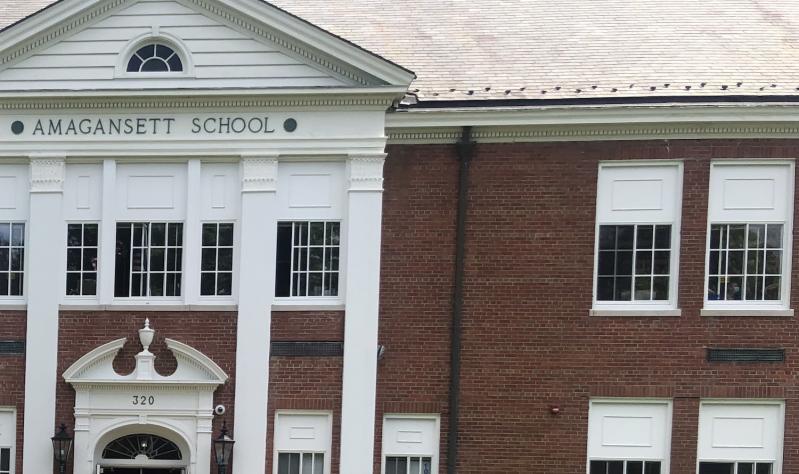Poised to have a surplus of more than $900,000 at the end of the current fiscal year, the Amagansett School District is planning to put much of it toward next year’s budget to offset the rising costs that nearly everyone — municipalities, businesses, consumers — is facing.
The school board on Tuesday voted 4-0 to put a $12.66 million spending plan on the ballot for 2022-23, which includes around $1.26 million from a surplus account known as the “unassigned, unrestricted fund balance.” That account already had a balance of hundreds of thousands of dollars.
It’s typical for a school district in good financial shape to end the year with unspent money, according to Tom Mager, the district treasurer. Those monies can then be used to offset the following year’s budget, as Amagansett is planning to do, or to save for specific purposes, such as workers’ compensation, retirement contributions for teachers and other employees, and upgrades to facilities.
“We’re giving back more than we’re saving this year,” Mr. Mager said during Tuesday’s budget presentation.
Year-over-year, Amagansett anticipates spending about $750,000 more than the current budget, an increase of 6.3 percent.
The proposed budget complies with New York State’s cap on tax-levy increases, meaning it will need only a simple majority of voter approval on May 17, when voters statewide head to the polls to weigh in on their school budgets and elect new trustees. The tax levy associated with Amagansett’s budget increase is 2.94 percent. That is higher than the “2-percent tax cap” that people are used to hearing because of factors unique to the district, such as real estate development within its borders and exclusions for debt payments.
In 2016, 63 percent of Amagansett voters said yes to an over-the-cap budget, but “We don’t anticipate having to do that in the near future,” Mr. Mager said.
The district will see the same tuition increase that other feeder-school districts are paying to send students in grades seven and up to East Hampton schools. However, unlike the nearby Springs School District, where enrollment fluctuations make it hard to project the number of high school students, Amagansett is not seeing the need to increase its $2.15 million tuition budget, which covers both general and special education.
There are now 58 Amagansett kids at East Hampton Middle and High Schools; next year, there will likely be 64, with a contingency of 15 more built in, in case new children move into the district or private school students opt to return to public school. The current enrollment at the Amagansett School itself is 129, from prekindergarten through sixth grade. During the height of the pandemic, enrollment was as high as 150 — about double what the school had been averaging before Covid.
The district is looking to expand its foreign language offerings, and an additional $7,000, up to $57,000, is budgeted for textbooks. To expand the music program with violin lessons, there is an additional $650 budgeted, up to $13,150.
Teachers and the superintendent will receive pay raises as per their contract, while the school principal, bus drivers, and other employees will receive 4-percent raises. The district anticipates adding a security guard at a salary of $100,000, and a salary increase for the school nurse. Health benefits, which are subject to midyear fluctuations, may rise as much as 10 percent. Money is also included for “mini projects” such as bamboo remediation, fencing and masonry work, and a new baseball field backstop.
Amagansett voters can also expect to see two propositions on the ballot in May. One is for a small school bus that Mr. Mager said “we absolutely need.” It will not increase taxes because the money is already set aside in a capital reserve account, but it needs separate voter approval, according to state rules. It is expected to cost around $60,000, but could take as long as six months to arrive.
“May 17 is the vote, May 18 is the day that Joe makes the phone call” for the bus, Mr. Mager said, referring to Joe Tucker, who coordinates busing.
The other proposition seeks permission to spend $450,000, also from a reserve account, to perform much needed repairs to the parapets and lintels, plus other maintenance projects.
There will be a public hearing on the budget at the school on May 10, at 5 p.m.
Mr. Mager also offered a preview of future finances, separating them into two categories. The first assumes tax-levy increases of around 2 percent each year in accordance with state limits. In that scenario, the district could face a budget deficit in the 2026-27 school year, but that is not written in stone; three years ago, the district also predicted a deficit.
“Well, now we’re in that year . . . and we’re not in that deficit,” the treasurer said.
The second scenario assumes variations in tax-levy increases. “Let’s be aware that if all things remain constant, we can’t increase our revenues, and expenditures are going up, there is a very real possibility of having to override the tax cap,” he said.
At the moment, he added, “We’re doing a good job at maintaining programs, even adding programs. We’re doing it all staying within the tax cap and not getting into a deficit.”

